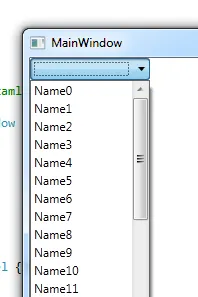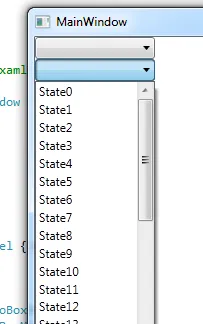目前,我已经硬编码了应该显示的DataContext对象的属性(DisplayName)。但通常情况下,您会在ComboBox本身中使用DisplayMemberPath属性指定此路径。我如何使用由DisplayMemberPath指定的值作为要绑定到内容呈现器中的属性?
<Style TargetType="{x:Type ComboBoxItem}">
<Setter Property="SnapsToDevicePixels" Value="True" />
<Setter Property="Template">
<Setter.Value>
<ControlTemplate>
<Border x:Name="ItemBorder"
Padding="2,0"
BorderThickness="1"
CornerRadius="3">
<ContentPresenter Content="{Binding DisplayName}"/>
</Border>
<ControlTemplate.Triggers>
<Trigger SourceName="ItemBorder" Property="IsMouseOver" Value="True">
<Setter TargetName="ItemBorder" Property="Background" Value="{StaticResource LightBlueBackgroundBrush}"/>
<Setter TargetName="ItemBorder" Property="BorderBrush" Value="{StaticResource LightBlueBackgroundBrush}"/>
</Trigger>
</ControlTemplate.Triggers>
</ControlTemplate>
</Setter.Value>
</Setter>
</Style>
以下是我的ComboBox样式,供参考。
<Style TargetType="{x:Type ComboBox}">
<Setter Property="SnapsToDevicePixels" Value="True" />
<Setter Property="ScrollViewer.HorizontalScrollBarVisibility" Value="Auto"/>
<Setter Property="ScrollViewer.VerticalScrollBarVisibility" Value="Auto"/>
<Setter Property="ScrollViewer.CanContentScroll" Value="true"/>
<Setter Property="Height" Value="22"/>
<Setter Property="Background" Value="White"/>
<Setter Property="BorderBrush" Value="{StaticResource MidGreyBorderStroke}"/>
<Setter Property="Border.CornerRadius" Value="3" />
<Setter Property="IsEditable" Value="False" />
<Setter Property="Template">
<Setter.Value>
<ControlTemplate TargetType="{x:Type ComboBox}">
<Border Background="{TemplateBinding Background}"
BorderBrush="{TemplateBinding BorderBrush}"
BorderThickness="1"
CornerRadius="{TemplateBinding Border.CornerRadius}"
Width="{TemplateBinding Width}"
Height="{TemplateBinding Height}">
<Grid>
<Grid.ColumnDefinitions>
<ColumnDefinition Width="*" />
<ColumnDefinition Width="Auto" />
<ColumnDefinition Width="Auto" />
</Grid.ColumnDefinitions>
<ContentPresenter x:Name="ReadOnlyContentPresenter"
Grid.Column="0"
Margin="5,0"
VerticalAlignment="Center"
HorizontalAlignment="Left"
Content="{TemplateBinding SelectionBoxItem}"
ContentTemplate="{TemplateBinding SelectionBoxItemTemplate}"
ContentTemplateSelector="{TemplateBinding ItemTemplateSelector}" />
<TextBox x:Name="PART_EditableTextBox"
Grid.Column="0"
Margin="5,0"
VerticalAlignment="Center"
HorizontalAlignment="Center"
Visibility="Hidden"
IsReadOnly="{TemplateBinding IsReadOnly}" />
<Border Grid.Column="1"
BorderBrush="{TemplateBinding BorderBrush}"
BorderThickness="1,0,0,0"
Margin="0,2" />
<ToggleButton Grid.Column="2"
Margin="1,0"
Background="{TemplateBinding Background}"
VerticalAlignment="Center"
HorizontalAlignment="Right"
Focusable="False"
IsChecked="{Binding Path=IsDropDownOpen, Mode=TwoWay, RelativeSource={RelativeSource TemplatedParent}}"
ClickMode="Press"
Style="{StaticResource ComboBoxToggleButton}"/>
<Popup x:Name="PART_Popup"
AllowsTransparency="True"
Placement="Bottom"
IsOpen="{TemplateBinding IsDropDownOpen}"
Focusable="False"
PopupAnimation="Fade"
SnapsToDevicePixels="True">
<Grid Background="Transparent"
MinWidth="{TemplateBinding ActualWidth}"
MaxHeight="{TemplateBinding MaxDropDownHeight}">
<Border x:Name="DropDownBorder"
Background="{TemplateBinding Background}"
BorderBrush="{TemplateBinding BorderBrush}"
BorderThickness="1"
CornerRadius="{TemplateBinding Border.CornerRadius}"
Margin="0,2,0,0">
<ScrollViewer Margin="6,0">
<StackPanel IsItemsHost="True"
KeyboardNavigation.DirectionalNavigation="Contained" />
</ScrollViewer>
</Border>
</Grid>
</Popup>
</Grid>
</Border>
<ControlTemplate.Triggers>
<Trigger Property="IsEnabled" Value="False">
<Setter Property="Opacity" Value=".65" />
</Trigger>
<Trigger Property="HasItems" Value="false">
<Setter TargetName="DropDownBorder" Property="MinHeight" Value="42"/>
</Trigger>
<Trigger Property="IsEditable" Value="True">
<Setter Property="IsTabStop" Value="false"/>
<Setter TargetName="PART_EditableTextBox" Property="Visibility" Value="Visible"/>
<Setter TargetName="ReadOnlyContentPresenter" Property="Visibility" Value="Hidden"/>
</Trigger>
</ControlTemplate.Triggers>
</ControlTemplate>
</Setter.Value>
</Setter>
</Style>

